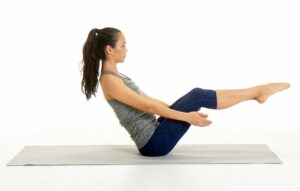Understanding what “core exercises to avoid” is by far one of the most common questions asked during pregnancy. So, this post will guide you through a simple rubric that can help you make more informed choices about what core exercises are right for you and reduce the fear that tends to accompany prenatal core work.
That said, before we get into what to avoid, we do want to emphasize the importance of building and maintaining a strong core that can withstand the stresses of pregnancy and childbirth, and recover more quickly afterward. Check out the #1 most effective core exercise to get you started.
Of course, we understand knowing what to avoid doing is an important piece of the prenatal training puzzle, so let’s get into that now. We’ll begin with a brief explanation of the key changes that happen in your core during pregnancy so that you can appreciate the whys behind our recommendations, and tailor our guidance to your specific situation.
How Pregnancy Impacts Your Core
The two biggest contributors to your prenatal core changes are the increase in intra-abdominal pressure (IAP) and the shifts in your alignment. Let’s discuss each.
1. Intra-Abdominal Pressure (IAP) Increase
When a body gains weight during pregnancy, it is primarily centered in the abdominal cavity. This added mass increases the pressure in that cavity, or intra-abdominal pressure (IAP). The increased pressure pushes outward onto the abdominal wall, which makes the left and right sides of the rectus abdominis (or “6-pack” muscle) spread further apart. You can see this in the right image below.

This “widening” of the gap between the left and right sides of the rectus abdominis muscle is known as Diastasis Recti (DR). A certain amount of DR is a normal and necessary part of pregnancy in order to make space for a growing baby. However, it’s important to minimize activities that further elevate this pressure, as this could make DR become more difficult to heal in the postpartum period. So, that is where some of our core exercise modifications come in.
2. Alignment Shifts
The other factor impacting core exercise modifications is that the growing belly tends to tip one’s pelvis forward — as you can see in the image below — which compresses the tissues in the low back (ouch!) and stretches the abdominal tissues (which already have stress on them from the increase in IAP that we just discussed). This gets compounded as weight gain increases.

Core Exercises to Avoid and Modify
The stresses discussed above come as a result of a growing belly. Therefore, the core exercise modifications pretty much start once you develop a belly. The goal is to stay strong while being sensible about your exercise choices so as not to place additional stress on your core. Here are some general guidelines that can help you do so. Once you develop a belly, begin to avoid the following types of movements:
- Spinal flexion (crunching): Sit-ups and crunches are obvious examples, as well as any other forward rounding that targets the abdominal muscles.

- Lateral flexion (sideways bending): Just as forward bending elevates pressure in the core, so too does loaded side-to-side bending.

- Spinal extension (arching): Deep stretches like upward dog and back-bends stretch the abdominal tissue (between the left and right sides of the rectus abdominus muscle) too much and could further widen the gap.

- Twisting: This means rotation with disassociation of hips and shoulders (hips move one way, shoulders move the opposite way). Rotation with your hips and shoulders in line – where your entire trunk moves as a unit — is perfectly safe to do throughout pregnancy. For further clarification, see Rotation Dos & Don’ts.

- Full planks (modify): Most people will likely need to begin modifying full planks once there is a medium size belly — especially center planks given the direct downward facing pressure on the belly. There are two key signs that indicate a need to regress: 1) loss of neutral alignment (losing the straight line between ear-shoulder-hip-knee-ankle, as you see in this photo — eeek!) and 2) “coning” in the belly (see “important notes” below). You can modify planks by performing them on your knees or on an incline. Once you have a large belly, we strongly recommend avoiding full center planks, as the direct downward facing pressure on the belly is just too great.

- Advanced back-lying or incline core work: Many core exercises performed on your back or on an incline – like the “Pilates 100s” and V-sit shown below — do not involve any crunching, arching, bending, or twisting, yet they still create excess IAP because of the degree of stress they place on the abdominal muscles. Therefore, they should be avoided as well.


- Breath-Holding Upon Exertion: This last one is not an “exercise,” but instead a behavior to avoid. Breath-holding upon exertion is also known as the Valsalva maneuver, and it is often used by those lifting very heavy weights (as you can see below). Holding your breath during exertion elevates the pressure within your core, which does result in greater force production. However, it has the side effect of placing excessive pressure on the abdominal wall and pelvic floor, which can exacerbate issues with Diastasis Recti (DR) and Pelvic Floor Dysfunction (PFD). Note, this is why DR and PFD are common among powerlifters, and others lifting very heavy loads. Another example of breath-holding upon exertion is “bearing down” on the toilet during a difficult bowel movement.


Unfortunately, constipation is common during pregnancy, given some of the hormonal changes. For tips on reducing constipation, see this post on 10 tips to reduce pregnancy constipation. Instead of breath-holding upon exertion, a much safer way to generate force is to exhale upon exertion (watch a video demo).
***2 Important Notes***
It is important to clarify two points regarding the recommendations above.
1. Modifications are for “loaded” moves (unloaded are fine): For all the exercises above, we are talking about loaded movements (strengthening exercises) or very deep stretches (as in the upward dog). Unloaded movements in these positions, or gentle stretches — like the cat-cow or kneeling side stretch shown below — are perfectly fine.


2. Watch for “coning” in your belly: It is impossible to provide a list of black and white “rules” that apply to every single person. Therefore, we provide the best general guidance we can, but then it is up to you to make the best decisions for your body — based on your activity history, belly size, conditions, etc. One very helpful tool to use is to watch for coning or a vertical torpedo-like protrusion down the center of your abdomen, as shown below. This is a sign that the movement being done exceeds the capacity of the core muscles at that time. If you see this — at any point (not just during pregnancy) – stop the movement, and regress (take down) until you no longer see the coning. This can be very helpful for determining when you need to start regressing exercises like planks.


Want Additional Resources?
For complete guidance on exercises, behaviors, and activities to avoid or modify, grab our Moves to Avoid by Trimester Guide.
For additional resources to help you exercise safely and effectively during pregnancy, explore our prenatal training programs and services. You’ll find a variety of offerings tailored to different needs — from education, to self-guided programs, to the ability to work with an expert coach.
Or, if you’re a health & fitness pro interested in coaching pre & postnatal clients, check out our ProNatal Education & Certification.

